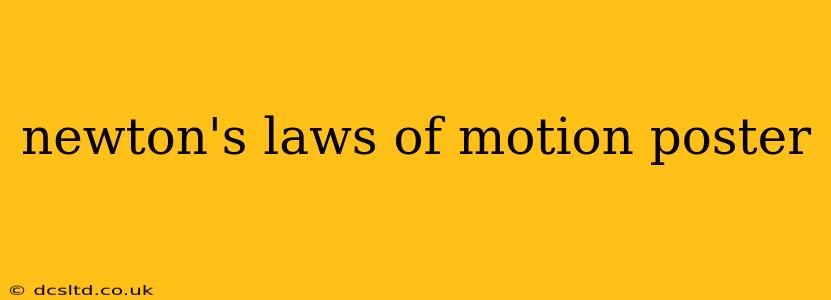Newton's Laws of Motion: A Poster-Worthy Explanation
Sir Isaac Newton's three laws of motion are fundamental principles in physics that describe the relationship between a body and the forces acting upon it, and its motion in response to those forces. Understanding these laws is crucial for comprehending how objects move in the world around us, from the simplest to the most complex systems. This guide delves into each law, providing a deeper understanding that goes beyond the basic definitions often found on posters.
Newton's First Law of Motion: Inertia
What is it? Newton's First Law, also known as the law of inertia, states that an object at rest stays at rest and an object in motion stays in motion with the same speed and in the same direction unless acted upon by an unbalanced force.
What does this mean? Inertia is the tendency of an object to resist changes in its state of motion. A stationary object will remain stationary unless a force pushes or pulls it. Similarly, a moving object will continue moving at a constant velocity (speed and direction) unless a force acts on it to change that velocity. Think of a hockey puck sliding across frictionless ice – it would continue sliding forever if no other forces interfered.
Examples:
- A book resting on a table: The book remains at rest because the forces acting on it (gravity pulling it down and the table pushing it up) are balanced.
- A car coasting to a stop: The car slows down and eventually stops because of the unbalanced force of friction acting against its motion.
Newton's Second Law of Motion: F=ma
What is it? Newton's Second Law states that the acceleration of an object is directly proportional to the net force acting on it and inversely proportional to its mass. This is often expressed as the equation: F = ma, where F represents force, m represents mass, and a represents acceleration.
What does this mean? This law explains how force, mass, and acceleration are related. A larger force results in a larger acceleration, while a larger mass results in a smaller acceleration for the same force. Acceleration is the rate of change of velocity—how quickly an object's speed or direction is changing.
Examples:
- Pushing a shopping cart: The harder you push (greater force), the faster it accelerates. A heavier cart (greater mass) will accelerate more slowly than a lighter one with the same force applied.
- Throwing a baseball: The force you apply to the ball determines its acceleration and therefore its speed.
Newton's Third Law of Motion: Action-Reaction
What is it? Newton's Third Law states that for every action, there is an equal and opposite reaction.
What does this mean? When one object exerts a force on a second object, the second object simultaneously exerts a force equal in magnitude and opposite in direction on the first object. These forces are called action and reaction forces.
Examples:
- Walking: You push backward on the ground (action), and the ground pushes forward on you (reaction), propelling you forward.
- Rocket launch: The rocket expels hot gas downwards (action), and the gas pushes the rocket upwards (reaction).
How are Newton's Laws Related?
Newton's three laws are interconnected. The first law describes the behavior of objects without net forces acting on them. The second law explains how net forces change the motion of objects. The third law shows that forces always come in pairs. Together, they provide a comprehensive framework for understanding classical mechanics.
What are some common misconceptions about Newton's Laws?
- Inertia is a force: Inertia is not a force; it's a property of matter that resists changes in motion.
- Action and reaction forces cancel each other out: Action and reaction forces act on different objects, so they don't cancel each other out.
- Newton's laws apply only to macroscopic objects: While initially formulated for macroscopic objects, Newton's laws can be applied, with modifications, to microscopic objects as well.
This in-depth explanation provides a more comprehensive understanding of Newton's Laws of Motion than a simple poster could offer, making it suitable for various educational levels and enhancing comprehension. Remember that application and experimentation are key to truly grasping these fundamental principles of physics.
